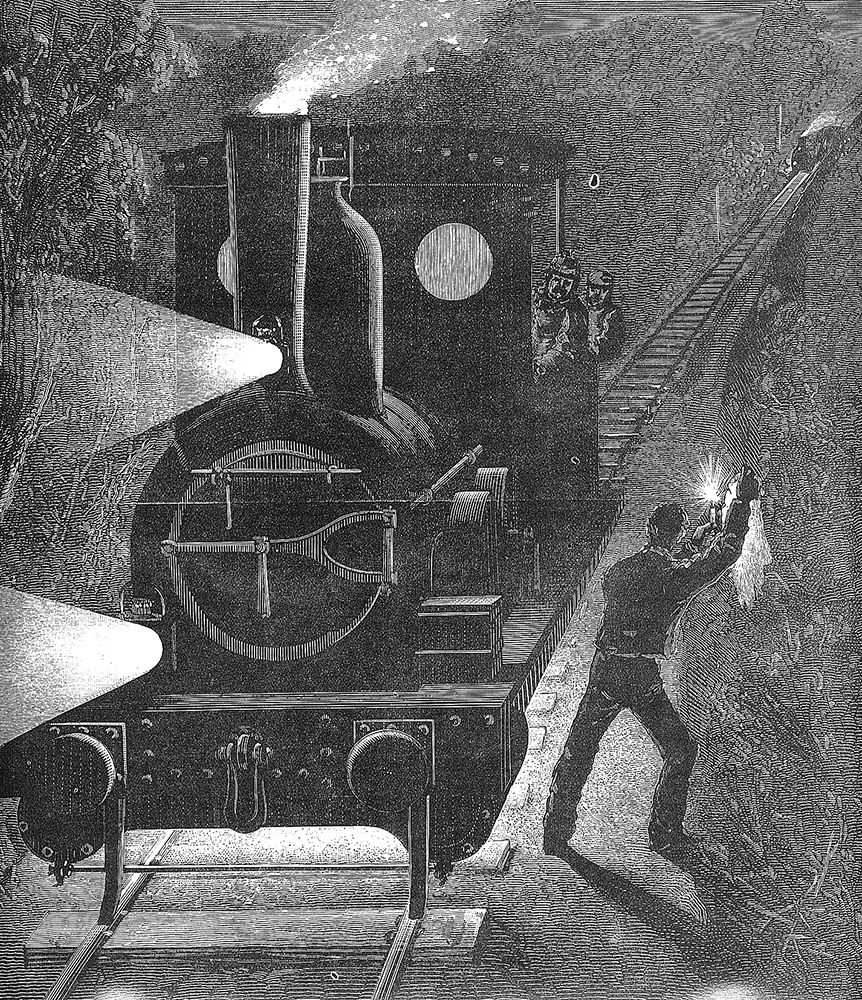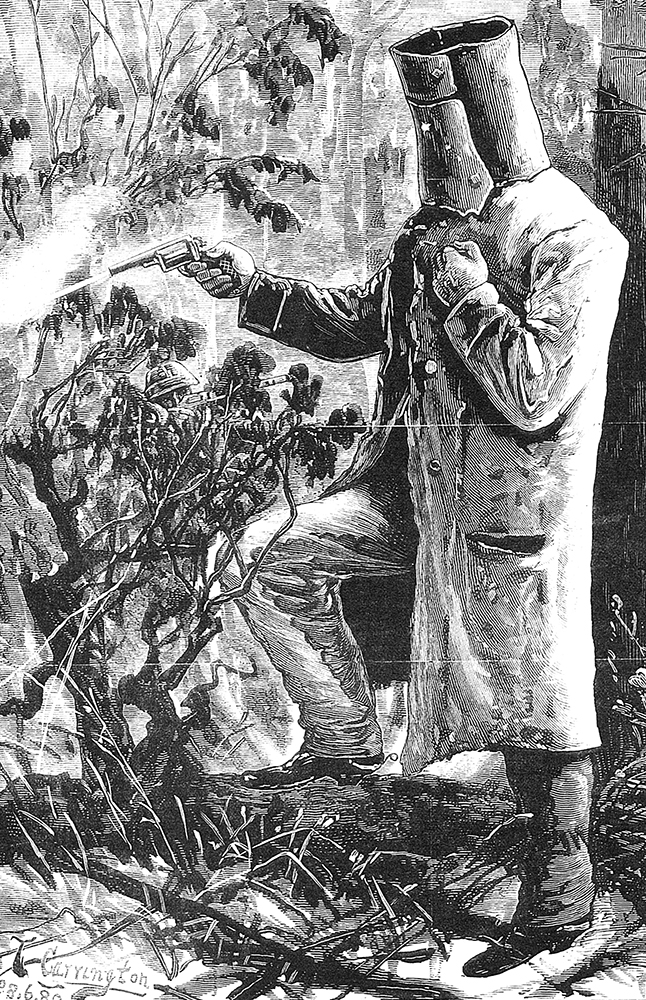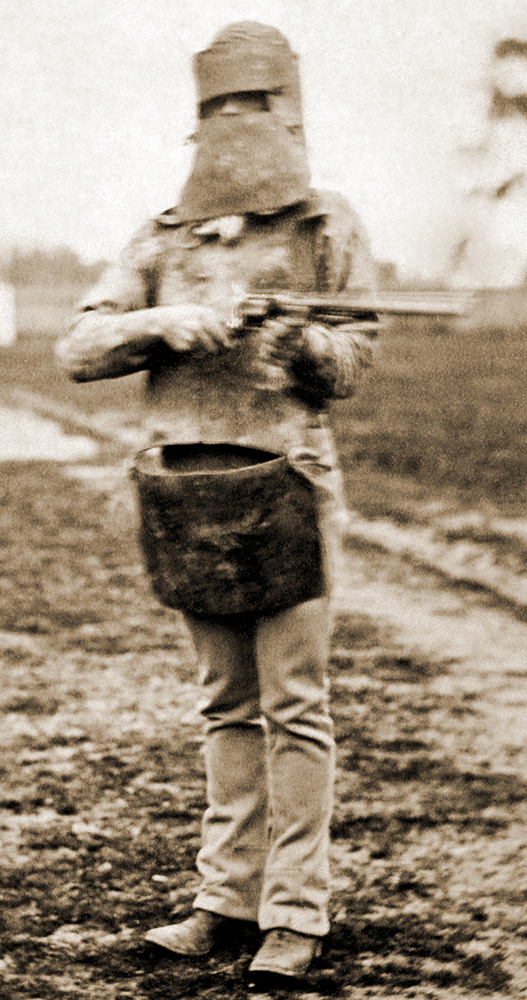Max Brown
No one is ever likely to know just what considerations influenced the Kelly Gang in the months preceding the battle of Glenrowan. If the shroud that surrounded so much of their lives was dark, then the reticence that enveloped relatives and friends following the climax of their story was darker still.
 What seems likely is that someone – probably Ned himself – dreamed up a checkmate to the banks’ new ring of security, and that once the idea was floated its very boldness gave purpose to everyone. The evidence is that mouldboards were stolen a few months after Jerilderie, and that the task of fashioning them into usable shape and quilting them kept the gang and their supporters busy throughout the entire 1879-80 summer.
What seems likely is that someone – probably Ned himself – dreamed up a checkmate to the banks’ new ring of security, and that once the idea was floated its very boldness gave purpose to everyone. The evidence is that mouldboards were stolen a few months after Jerilderie, and that the task of fashioning them into usable shape and quilting them kept the gang and their supporters busy throughout the entire 1879-80 summer.
Ned and Joe meanwhile were casting around for a strategic objective and tactical plans. The betrayal of Maggie and withdrawal of the Glenrowan watch party may well have supplied the occasion sought. Sherritt would be executed, and his execution used to draw the special force from Benalla, so leaving its two banks unprotected. The town would then be isolated by cutting the rail links north and south.
To cut the line from Melbourne was simple. The rail bridge would be blown with gunpowder, and the road bridge too, if necessary. But where to cut the line to stop the special to Beechworth? The answer was obvious – right in the midst of their staunchest support, at Glenrowan which was without either Sunday rail traffic or telegraph.
Prelude to a Republic

It is tempting to picture the gang with their supporters – the telegraphs who had taken part in the raids on Euroa and Jerilderie, Tom Lloyd and others who had been involved in the complex job of securing the mould-boards and forging four suits of armour. Men come and go – cocky farmers, goldminers, sympathisers with barely two bob to rub together, members of the Greta mob, most of them young and Australian-born. Dan comes and goes, arranging transport of the armour. In the centre sits Joe Byrne, busily writing out instructions, checking times and ticking items off a list. Beside him stands Ned, warm and genial, shaking old friends by the hand and referring now and then to a sketch map, the light of confidence in his eye. Steve is dispatched on the greatest ride of his life to sound the tocsin in many a gully and flat.
The armour had been the subject of endless debate, especially as it made accurate aiming of a rifle impossible. Yes, it was proof to a Martini-Henry bullet at ten paces. But extra horses were needed to carry it, it had to be put on and off, which was time-consuming in the best of conditions. A new set of habits was required. In other words, the members of the gang would have to learn how to wear it; new disciplines were required to replace natural habit. There were too many unknown factors, said Joe, and the weight was terrible. It was approximately that of a bag of wheat, in other words about as much as a strong man could carry. To compensate for the inaccuracy of fire associated with the armour, Ned bought four rapid-fire Winchester repeaters and shortened the barrels. The gang now had several score men ready to take up arms. No doubt the armour captured their imaginations and it was their preference which swung the argument.
The plan was to derail the police special on a bend just north of the Glenrowan station, hand the survivors over to the Greta Mob with instructions to make for the hills, and then to ride the hop-step-and-jump to Benalla and blow the bridges. Ned, Joe, Dan and Steve, encased in armour, would serve as shock troops, fronting for their auxiliaries. Hare and his men would be captured and held hostage until such time as the Melbourne authorities saw fit to release Mrs Kelly. This, at any rate, is what Kelly indicated after the event.
Inside the Jones Inn
What had seemed right and necessary after months of being hounded by spies and black trackers, may now have seemed unnecessary to the outlaws. Back in the warmth of human society, even the police became human. Their plans had worked out well enough to date despite the special’s lateness, and their force was safe and intact. Rather than wreck the special with the resulting broken limbs, injured horses and other consequences, they decided on an alternative. Ned and Joe re-briefed the bush telegraphs and Greta Mob at McDonnell’s and Ned took a picked man to the gatehouse and instructed him in the use of the signal lamp. This would stop the special opposite the barracks, leaving the locomotive to proceed to the station where the horses could be unloaded. Safe in armour, the gang would meanwhile drive the police into the barracks where the Greta Mob would keep them cooped up. While the police mounts were driven into the hills, the gang would ride the police special back to Benalla.
Dan and Steve brought out armour forged from the ploughshares, begged or stolen, and showed it to the amazed prisoners. The iron was as thick as a dinner plate and quilted inside. Kelly repeated his declaration that he would be on the spot when the train ran over the culvert and would shoot all who were not killed. Upon request, Mortimer brought out his concertina and someone sang a Scottish reel. Mrs Jones offered her son sixpence to sing The Wild Colonial Boy, and the spirit of convict days not long since lived again amid the shadows cast by the fire.
Arrival of the Police Train
The outlaws hurried to the inner room and got busy on their strange toilet. They had no sooner turned their backs than Bracken, who had taken good note where the door key was hidden, walked over and slipped it in his boot. From the rear of the hotel, the frightened prisoners could hear smothered curses and the clang of armour, and from the front, the sound of the special steaming into the station. Then came the thud of feet from the back of the inn, at which Bracken unlocked the front door and made for the station. The excitement waxed intense at the clatter of horses being unloaded and the sound of police making their way towards the hotel in whose shadow, cast by the harvest moon, the outlaws stood waiting.
 Thomas Curnow, the Glenrowan school teacher, persuaded Ned Kelly to release him from the Glenrowan Inn. He stopped the police train with a candle held behind a red scarf. Image: Max Brown
Thomas Curnow, the Glenrowan school teacher, persuaded Ned Kelly to release him from the Glenrowan Inn. He stopped the police train with a candle held behind a red scarf. Image: Max Brown
The police accounts of who opened fire in the battle of Glenrowan are contradictory. Hare claimed that his men fired fifty or sixty shots and the outlaws thirty or forty before he gave the order to stop firing. He was close to the inn when he saw the flash of a rifle and felt his left hand go limp, he said. Then three flashes followed from the veranda. Whoever had first fired at him stepped back and began to fire again. A voice cried, “Fire away you beggars, you can do us no harm,” and a trooper by his side said, “That is the voice of Ned Kelly.”
Kelly claimed that he arrived opposite the station and was dismounting to bail up the police when a bolt in his armour failed. By the time he had adjusted it, the police were firing into the inn. Hearing screams, he thought at first they came from Mrs Stanistreet and Hart had been cornered. He was half way between the gatehouse and the inn when he received a bullet in the foot and immediately after another in the left arm. It was only then, he declared, at the third volley, that he and his mates replied to police fire. As his armour required him to hold the rifle at arm’s length to get anything of a sight and his arm was smashed, he fired at random at the flashes through the wraiths of gunpowder smoke drifting across the field – two shots to the front and two shots to the left.
“I’m afraid it’s a case with us this time.” “Don’t be so excited. The boys will hear us and it will dishearten them.” “Well, it’s your fault. I always said this bloody armour would bring us to grief.” “Don’t you believe it. Old Hare is cooked and we’ll soon finish the rest.”
Through the gloom appeared Dan and Steve. Ned sent them inside, Joe followed and the three clanked up the passage. As the bullets hummed off the armour, they pulled up the bar counter and partitions, barricaded the walls and cursed the police. To the prisoners Byrne appeared completely reckless – as though he did not care whether he lived or died. He marched up to the bar and had just poured himself a nobbler of whisky when a bullet found its way through a gap in his armour and cut the femoral artery. “Many more years in the bush for the Kelly gang,” he cried, and turning round twice, fell to the floor with a clang, the blood rushing from his groin.
Ned Kelly's Armour by Thomas Carrington 1880

The Bunyip
Constable Arthur was lighting his pipe when he heard something behind him. He turned and the sight so surprised him that the pipe dropped from his mouth. Advancing through the timber from the Lookout was a figure in grey cotton coat reaching past the knees. Most extraordinary of all was the head. Arthur goggled for several seconds before he concluded that some madman had conceived the notion of storming the hotel with a nailcan on his head. “Go back, you damn fool; you’ll get shot,” he shouted. The apparition, no more than thirty metres off, replied, “I could shoot you, sonny.” No sooner said than he lifted a revolver, placed it across his forearm and fired. The bullet went wide. Someone pointed to the figure and shouted, “Look at this!” With big head and shoulders looming through the mists of dawn it looked like a huge blackfellow wrapped in a blanket. “Challenge him, and if he doesn’t answer, shoot!” cried Senior Constable Kelly.
 ‘Ned Kelly at bay’ as drawn by Thomas Carrington. Watching from more than 100 metres away, Carrington was unaware that the oilskin coat was actually draped over Ned’s shoulders like a cloak. Other authentic details like the helmet, ‘strapped’ riding pants and spurred riding boots were sketched after Ned’s capture. Image: Max Brown
‘Ned Kelly at bay’ as drawn by Thomas Carrington. Watching from more than 100 metres away, Carrington was unaware that the oilskin coat was actually draped over Ned’s shoulders like a cloak. Other authentic details like the helmet, ‘strapped’ riding pants and spurred riding boots were sketched after Ned’s capture. Image: Max Brown
Arthur lifted his Martini and fired at the helmet, thinking to knock it off. The figure no more than staggered and continued to come, deliberately advancing one foot after the other with a macabre lurching motion and edging towards the rear of the inn. An opening in the helmet looked like a large mouth. Arthur fired a second shot. The figure staggered again but still came on. He fired again and heard the bullet spin off. Amazed cries came from the troopers. Someone shouted, “It’s a ghost!” Dowsett exclaimed, “It’s old Nick himself!” Senior Constable Kelly cried, “Look out, boys, it’s the bunyip. He’s bullet-proof!”
Ned had been lying on the rising ground in sight of the inn, bleeding in his cold mountain of iron and barely conscious, with who knows what thoughts, what bitterness racking him. Earlier, he had been near the tree where Arthur had found the revolving rifle and had refrained from shooting Steele in the back. At that point Tom Lloyd had found him and helped him to adjust his armour. Now, feeling somewhat revived, he was out to rally the other two. He rapped on his breastplate with his revolver butt, and Dan and Steve came to the rear and commenced firing. “Come out, boys, and we’ll whip the lot of them,” he cried, his voice echoing from behind the vizor.
The police poured bullets at him. Arthur fired, Phillips fired, Healy discharged both barrels of his shotgun. A chorus of shots broke out over the ground; those who could not see the outlaw fired into the inn from which the screams of woman and children broke out afresh. In spite of wounds in his foot, arm and right hand, Ned continued to advance, bearing the great weight of iron, staggering under the impact of the hits and firing deliberately but inaccurately at the inner ring of his attackers. He was laughing; at last he was discharging the terrible debt that had been accumulating since childhood.
Beginning of the End
 Policeman posing in suit of Kelly Gang armour with Ned Kelly’s rifle and silk cap (June 1880).
Policeman posing in suit of Kelly Gang armour with Ned Kelly’s rifle and silk cap (June 1880).
Ned rose, fired carefully at Steele who was wiping from his eyes dirt flung up by a bullet from the inn, and headed towards Dowsett. He had approached within fifteen metres when the railway guard cried, “You’d better surrender old man, you’re surrounded.” “Never, while I have a shot left,” cried Kelly. As if to warn her master, the outlaw’s grey mare passed a few metres to the rear and Kelly turned to find Steele advancing at a run, swinging his gun as if to club him. He tried to aim his revolver. Steele fired at his knees, and he staggered back. Steele fired again at point blank range, scoring Kelly’s hand and hip with swanshot. The outlaw tottered. His voice boomed under the helmet, “I’m done, I’m done!”
Dr Nicolson asked what the armour meant. Ned replied that he had intended to fight it out and paste as many of the traps as he could before they got him. He was sick of his life. He was hunted like a dog, could get no rest and didn’t give a damn what became of him.
In the days that followed, reports of the siege of Glenrowan appeared wherever the English language was spoken. A spate of messages leapt across the continent according to the principle, Unto everyone that hath shall be given”. The Chief Secretary Mr Ramsay, Superintendent Hare and Chief Commissioner Standish received congratulatory telegams from Lord Normanby in Melbourne and Lord Augustus Loftus, Governor of New South Wales. From London came a comment from a young medical student, Arthur Conan Doyle, who remarked on the outlaw’s imagination and recommended armour for use by infantry. Military chiefs concerned with stamping out insurrection in India remarked in enlightened moments that the Kellys would have made fine soldiers.
Further Reading:
Forging The Kelly Gang Armour by Nick Hawtin
Kelly Gang Armour: The Myths, The Facts by Noeleen Lloyd
